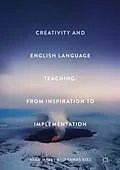This book offers a unique perspective on creativity in an educational environment where there is a relative dearth of literature on this subject. The authors link practice and principle to provide a practical and valuable guide for more creative language learning and teaching, using not only theoretical ideas but useful practical advice and recommendations on how better to introduce creativity into teaching and daily life. This innovative volume is sure to become a crucial reference point for teachers and practitioners of language teaching, and anyone interested in the ways in which creativity can be channelled into the teaching and learning process.
Alan Maley has worked in the field of English Language Teaching for over 50 years. He has lived and worked in 10 countries, including India and China. He has published over 40 books in the field of language teaching. He is a Past President of IATEFL and in 2012 received the ELTons Lifetime Achievement Award. His research interests lie primarily in creative writing and innovative materials development.
Tamas Kiss is Associate Professor at Xi'an Jiaotong - Liverpool University, China. He has been involved with language teacher education programmes in Europe, the Middle East, South Asia, Latin America and South East Asia. His main interests include language teacher education, materials development, complexity science, language as a complex dynamic system and creativity.
Autorentext
Inhalt
Chapter 1. Introduction.- Chapter 2. Creativity Theory.- Chapter 3. Creativity and Education.- Chapter 4. Creativity and Applied Linguistics.- Chapter 5. Creativity and Methodology.- Chapter 6. Creativity in Materials and Resources.- Chapter 7. What is a creative teacher?.- Chapter 8.- Becoming a creative person.- Chapter 9. Becoming a creative teacher.- Chapter 10. Pre-conditions for classroom creativity.- Chapter 11. Some possible frameworks and procedures.- Chapter 12. Measuring Creativity.- Chapter 13. Research into creativity.- Chapter 14. Network analysis of research papers on creativity in ELT.- Chapter 15. Suggestions for further research.- Chapter 16. Conclusion.
Alan Maley has worked in the field of English Language Teaching for over 50 years. He has lived and worked in 10 countries, including India and China. He has published over 40 books in the field of language teaching. He is a Past President of IATEFL and in 2012 received the ELTons Lifetime Achievement Award. His research interests lie primarily in creative writing and innovative materials development.
Tamas Kiss is Associate Professor at Xi'an Jiaotong - Liverpool University, China. He has been involved with language teacher education programmes in Europe, the Middle East, South Asia, Latin America and South East Asia. His main interests include language teacher education, materials development, complexity science, language as a complex dynamic system and creativity.
Autorentext
Alan Maley has worked in the field of English Language Teaching for over 50 years. He has lived and worked in 10 countries, including India and China. He has published over 40 books in the field of language teaching. He is a Past President of IATEFL and in 2012 received the ELTons Lifetime Achievement Award. His research interests lie primarily in creative writing and innovative materials development.
Tamas Kiss is Associate Professor at Xi'an Jiaotong Liverpool University, China. He has been involved with language teacher education programmes in Europe, the Middle East, South Asia, Latin America and South East Asia. His main interests include language teacher education, materials development, complexity science, language as a complex dynamic system and creativity.
Inhalt
Chapter 1. Introduction.- Chapter 2. Creativity Theory.- Chapter 3. Creativity and Education.- Chapter 4. Creativity and Applied Linguistics.- Chapter 5. Creativity and Methodology.- Chapter 6. Creativity in Materials and Resources.- Chapter 7. What is a creative teacher?.- Chapter 8.- Becoming a creative person.- Chapter 9. Becoming a creative teacher.- Chapter 10. Pre-conditions for classroom creativity.- Chapter 11. Some possible frameworks and procedures.- Chapter 12. Measuring Creativity.- Chapter 13. Research into creativity.- Chapter 14. Network analysis of research papers on creativity in ELT.- Chapter 15. Suggestions for further research.- Chapter 16. Conclusion.
Titel
Creativity and English Language Teaching
Untertitel
From Inspiration to Implementation
Autor
EAN
9781137467294
ISBN
978-1-137-46729-4
Format
E-Book (pdf)
Hersteller
Herausgeber
Veröffentlichung
05.10.2017
Digitaler Kopierschutz
Wasserzeichen
Dateigrösse
4.05 MB
Anzahl Seiten
339
Jahr
2017
Untertitel
Englisch
Features
Unterstützte Lesegerätegruppen: PC/MAC/eReader/Tablet
Unerwartete Verzögerung
Ups, ein Fehler ist aufgetreten. Bitte versuchen Sie es später noch einmal.
